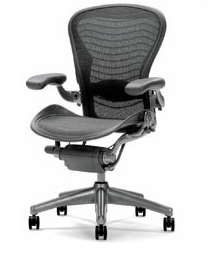
Ergonomics: N. The applied science of equipment design, as for the workplace, intended to maximize productivity by reducing operator fatigue and discomfort.
Office ergonomics have become one of the most important factors in choosing office furniture for a workplace. An obvious leader of ergonomics is the task chair; having evolved into various dynamic models across manufacturers to comfortably fit and maximize the health of every body type.
Certain names and styles have become popular among the office world, but finding the right chair for you is another story. Here’s how you can make sure you’re looking for the right characteristics to help you get the most out of your chair:
- When adjusting seat height, sit upright in your chair and adjust accordingly so that your feet are flat on the floor and your thighs are a 90-degree angle to your calves.
- Your seat pan size should be the right depth so that when you’re sitting back in your chair, it does not contact the back of your knees. It should also not be too wide that you are caused any discomfort or back tilt in reaching your elbow to your arm rests.
- Multi-function mechanism allows you to adjust your seat and back independent of one another, multiplying the number of possibilities for how to sit. These adjustments include tilt lock, tilt tension, seat tilt, etc. These mechanisms will be positioned from the center of your seat. Synchro-tilt mechanism links the seat and back tilts simultaneously. This option is less ergonomic, but may be all you need to achieve your necessary comfort.
- The backrest should slide up and down to allow the curves in the seat to match with the curve of your back no matter what height you are. More and more chairs are being designed to model after the human spine to allow this. Your chair should also have a back angle adjustment, which is helpful to allow you to recline to various degrees and thus relieve stress off your lower back. If this is important to you, then you may want to look for a chair with locking back angle adjustments, so you can find what position is most comfortable and keep it locked there.
- Back tilt tension will have an adjustment knob that allows you to change the amount of force it will require for you to lean back. This can be an important factor depending on your body weight.
- Your armrests can either be adjustable synchronized or independent of one another, but either way, they should at least allow you to change their height. This will be a factor depending on your height, so you aren’t altering your natural posture to reach the armrest. If your arms are bent and at rest, the arm rests should never be above your elbows. A swing back arm rest will also allow the user to move the arm rest out of the way completely, and pivotal arm rests can be moved to aid your position while typing.
